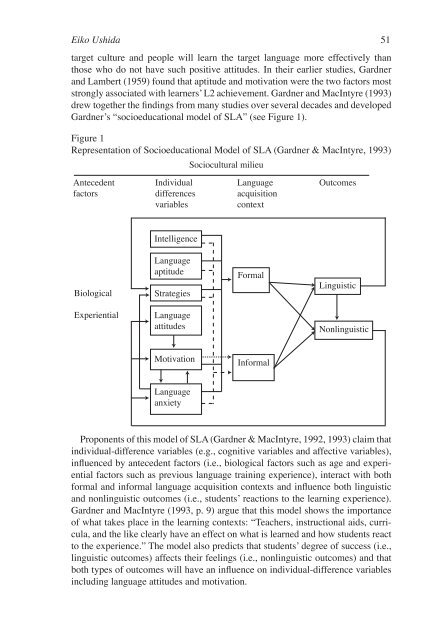The Role of Students' Attitudes and Motivation in Second ... - CALICO
The Role of Students' Attitudes and Motivation in Second ... - CALICO
The Role of Students' Attitudes and Motivation in Second ... - CALICO
Create successful ePaper yourself
Turn your PDF publications into a flip-book with our unique Google optimized e-Paper software.
Eiko Ushida 51<br />
target culture <strong>and</strong> people will learn the target language more effectively than<br />
those who do not have such positive attitudes. In their earlier studies, Gardner<br />
<strong>and</strong> Lambert (1959) found that aptitude <strong>and</strong> motivation were the two factors most<br />
strongly associated with learners’ L2 achievement. Gardner <strong>and</strong> MacIntyre (1993)<br />
drew together the f<strong>in</strong>d<strong>in</strong>gs from many studies over several decades <strong>and</strong> developed<br />
Gardner’s “socioeducational model <strong>of</strong> SLA” (see Figure 1).<br />
Figure 1<br />
Representation <strong>of</strong> Socioeducational Model <strong>of</strong> SLA (Gardner & MacIntyre, 1993)<br />
Antecedent Individual Language Outcomes<br />
factors differences acquisition<br />
variables context<br />
Biological<br />
Experiential<br />
Intelligence<br />
Language<br />
aptitude<br />
Strategies<br />
Language<br />
attitudes<br />
<strong>Motivation</strong><br />
Language<br />
anxiety<br />
Sociocultural milieu<br />
Formal<br />
Informal<br />
L<strong>in</strong>guistic<br />
Nonl<strong>in</strong>guistic<br />
Proponents <strong>of</strong> this model <strong>of</strong> SLA (Gardner & MacIntyre, 1992, 1993) claim that<br />
<strong>in</strong>dividual-difference variables (e.g., cognitive variables <strong>and</strong> affective variables),<br />
<strong>in</strong>fluenced by antecedent factors (i.e., biological factors such as age <strong>and</strong> experiential<br />
factors such as previous language tra<strong>in</strong><strong>in</strong>g experience), <strong>in</strong>teract with both<br />
formal <strong>and</strong> <strong>in</strong>formal language acquisition contexts <strong>and</strong> <strong>in</strong>fluence both l<strong>in</strong>guistic<br />
<strong>and</strong> nonl<strong>in</strong>guistic outcomes (i.e., students’ reactions to the learn<strong>in</strong>g experience).<br />
Gardner <strong>and</strong> MacIntyre (1993, p. 9) argue that this model shows the importance<br />
<strong>of</strong> what takes place <strong>in</strong> the learn<strong>in</strong>g contexts: “Teachers, <strong>in</strong>structional aids, curricula,<br />
<strong>and</strong> the like clearly have an effect on what is learned <strong>and</strong> how students react<br />
to the experience.” <strong>The</strong> model also predicts that students’ degree <strong>of</strong> success (i.e.,<br />
l<strong>in</strong>guistic outcomes) affects their feel<strong>in</strong>gs (i.e., nonl<strong>in</strong>guistic outcomes) <strong>and</strong> that<br />
both types <strong>of</strong> outcomes will have an <strong>in</strong>fluence on <strong>in</strong>dividual-difference variables<br />
<strong>in</strong>clud<strong>in</strong>g language attitudes <strong>and</strong> motivation.
















